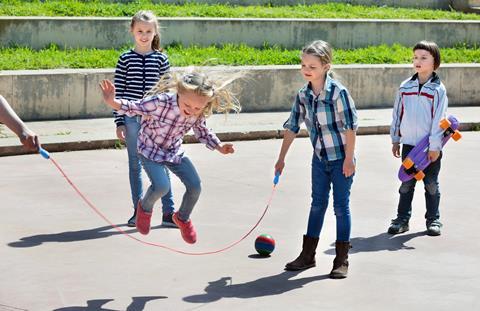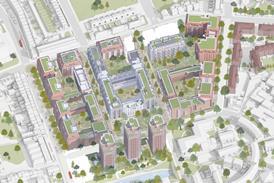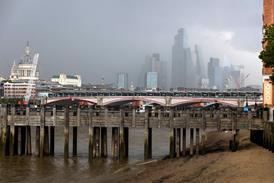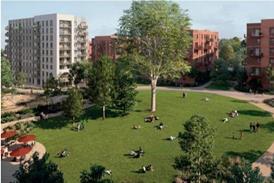Gemma Hyde explains how the TCPA and its partners in the built environment sector have been working to reclaim space for children and young people

We have all been children. Childhood, unlike many other life experiences, is universal, and it is difficult not to compare our experiences to those we observe children having today. It is, of course, easy to look back with rose-tinted glasses, with ‘memory and myth’ about what it was like to inhabit the streets and neighbourhoods of our time, but equally, it is a powerful catalyst for action.
Reclaiming space for children and young people
Giving evidence to a parliamentary select committee inquiry on children, young people and the built environment in January this year, I was struck by how many of the interactions between the inquiry participants were framed through reflections by the MPs on their own childhood experiences. For example, Ian Byrne, MP:
“When you are talking, I am just thinking back. In the summer, we used to have a car park that would be a tennis court, a cricket field, or a football pitch. Everybody would play out in the street on it. That was where you would go.”
Or this from Clive Betts MP (Committee Chair):
“I am also starting to regress back and think about my own experience – it was a long time ago – of playing football and cricket in the street. At that time, the only time we had to stop for a few minutes was when the ice cream van arrived because it was the only vehicle we saw all day.”
There is a danger, of course, of giving in to nostalgia, but these memories and the sense that something has changed, and not for the better, can act as a catalyst – not to return us to the ‘good old days’ but to stop, think again and ask afresh of children, young people, and their caregivers: what do you want? What do you need? What would bring you back to the city, the streets? Because we no longer see children, no longer hold space for them, no longer invite them to explore the spaces and streets that make up their neighbourhoods. They are a missing presence, and we are all suffering for it.
How the child sees the city
In The Child in the City, Colin Ward states that “the child’s world is full of miracles”. Anyone who has ever had the pleasure (or pain) of walking anywhere with a toddler can relate to the levels of fascination that sticks, puddles, cracks in the pavement, bollards, kerbs, and ditches can evoke. Textures, changes in ground levels, paths, and boundaries are all physically close to a young child, presenting opportunities for interaction, risk, learning, and development.

The Bernard van Leer Foundation’s Urban95 initiative communicates this through the core question: “If you could experience the city from 95 cm – the height of a healthy 3-year-old – what would you change?” They have developed three lessons for toddler-friendly cities, including that ‘think babies’ should be a universal design principle, which is likely to create spaces and environments that ultimately work for everyone. This is similar to the 8 80 Cities approach, where place shaping is “guided by the simple but powerful idea that if everything we do in our cities is great for an 8-year-old and an 80-year-old, then it will be better for all people”.
An absence in policy and practice
Both approaches speculate, like Ward, that there are ways to create places and spaces where the relationships between people and their environments can be more fruitful and enjoyable for all when the needs of children and young people are embraced. And yet, in English planning policy, and too often in practice, children and young people are not mentioned and not considered. In the main body of the National Planning Policy Framework for England, children are mentioned only once – in relation to providing housing for families. The words ‘youth’ and ‘young’ are entirely absent.
There is a void in national policy and direction, and so it is not surprising that local planning policy so often fails to address the needs of children and young people. The government is failing to take a lead, despite the wealth of evidence suggesting that the built environment is a key determinant of health.
For children and young people, who are developing rapidly both physically, emotionally, and socially, this means that their environments can have a profound impact upon their educational performance, social and emotional development, work outcomes, income, and lifelong physical and mental health, including life expectancy.
Happy habitats
All lives are inherently spatial – they happen somewhere. For children, the spatial geographies they inhabit are generally smaller than for adults: home, doorstep, street, school. Since 1980, opportunities for independent play and mobility have been restricted by the entrenched spatial injustice of streets being given over to cars.

Groups like Playing Out, a resident-led organisation that supports temporary ‘play takeovers’ of streets across the UK, state that the car is the number one immediate barrier to children playing outside. Residential streets used to be multi-purpose but have become monocultural places for driving through and car storage, pushing children out of what was once communal space. Many studies have shown that increased traffic danger is the main reason children play out less than they used to. And there is a vicious cycle: the fewer children seen outside, the more roads become just for cars. Children are losing out, and this needs to be addressed in planning and design, in addition to providing access to formal and informal play and public spaces that exist for, and welcome, children and young people.
The TCPA: ‘a vehicle for the empowerment of the child’
The TCPA’s vision is for homes, places, and communities in which everyone can thrive. The mission is to challenge, inspire, and support people to create healthy, sustainable, and resilient places that are fair for everyone – including children and young people.
Children fundamentally seek the same characteristics from their urban environment as everyone else: a healthy, safe, and secure place to call home, safe and clean streets, access to public and green spaces, clean air, things to do, the ability to confidently get around, and the freedom to see friends and feel like they belong. Many of these things are represented in the Garden City principles and place-making frameworks like the 20-minute neighbourhood.
>> Also read: We are neglecting the needs of young people, planning experts tell MPs
Planning and designing cities from a child’s perspective has the potential to be a unifying aid in tackling place-based challenges across many contexts. It focuses not only on what the physical environment looks like but also on the way in which it works and the relationships it supports or hinders for some of the most vulnerable members of society.
For the last decade, the TCPA has worked in collaboration on healthy place-making, pursued and supported the principles of 20-minute neighbourhoods, and partnered with Sport England and others on the youth engagement toolkit Voice Opportunity Power.
Developing well
Due to the May general election, the parliamentary select committee inquiry on children, young people and the built environment closed before publishing its final report. However, there remains a groundswell of interest and passion to revisit and see positive change in the relationship between children, young people, and built environment professionals.
The TCPA will continue to explore an inclusive approach to place-making that re-centres, engages, supports, and promotes the rights of the child to not only live in the city but shape it at all scales. Collaborating with Playing Out, Fields in Trust, Tim Gill, and Dinah Bornat, the TCPA is working on a review of the evidence submitted to the inquiry. The aim of the review is to summarise the evidence base collected by the Committee and identify key themes and recommendations. We hope this piece of work will be of use to many organisations in influencing politicians and the built environment sector to create places and spaces where children and young people thrive.
Boomers to Zoomers: Designing for the Generations

Building Design has launched a campaign focused on different intergenerational design needs.
In the coming months, Boomers to Zoomers will look at the underlying challenges we face in designing for different generations. It aims to highlight the need for architectural solutions that cater to all age groups.
The campaign will focus on a range of topics including designing for children and young people, intergenerational living and new models for housing, workplace issues, later-living and education and skills.
Email us at ben.flatman@bdonline.co.uk or use the hashtag #boomerstozoomers
BD’s campaign is being guided by an editorial panel, drawing on expert advisers from across architecture, planning and urban design. The panel includes:
- Dinah Bornat, founding co-director of ZCD Architects
- Alex Ely, founding director of Mae Architects
- Darryl Chen, partner at Hawkins Brown
- Satish Jassal, founding director of Satish Jassal Architects
- Kathy MacEwen, independent planning consultant and former head of planning and enabling at CABE
- Anna Mansfield, director at Publica
- Setareh Neshati, head of development at Westminster City Council
- Sarah Robinson, associate director at The King’s Foundation
- Peter Sofoluke, director at BPTW architects
Click here to find out more.
Postscript
Gemma Hyde is the Town and Country Planning Accosication’s (TCPA) project and policy manager.
This is an edited version of an article that was first published in the July/August edition of Town & Country Planning Journal.
Recordings from the TCPA’s recent Developing Well conference, can be found here.
















No comments yet